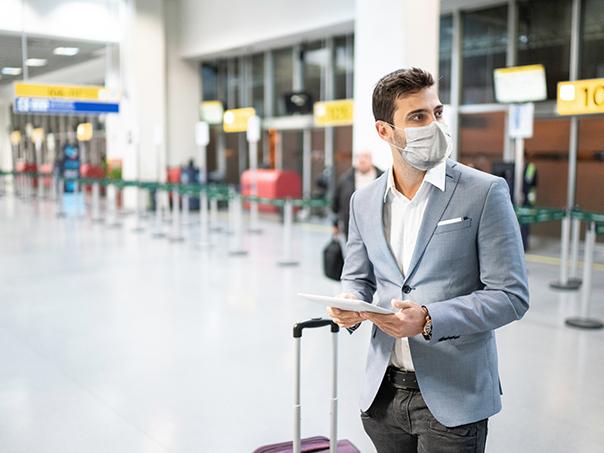A comprehensive checklist for overseas business travel
After two long years of closed borders, corporate travel is once again on the agenda – and if you’re anything like us, we know you’ll be itching to dust off those passports and get travelling.
We’ve always been advocates of well-planned business travel, not only to stop business travellers showing up to the airport sans passport but because preparation is fundamental to traveller health and safety as well as managing travel expenses.
Throw COVID-19 into the mix, and there’s no denying that international travel is now more complex than ever. After a two-year hiatus, you might find business travellers are a little rusty when it comes to planning and preparing for long-distance travel.
Before setting foot in an unfamiliar city, business travellers need to consider the risks that come with overseas travel. It’s more than just booking a flight and packing a suitcase (although these are key components).
“There’s a lot that travellers need to do before they even get to the booking stage, and that’s where a TMC comes in,” says Lisa Hooper, Customer Experience Leader.
To take the stress out of returning to international business travel, we’ve pulled together this comprehensive travel checklist (along with some useful expert tips). It’ll help you save prep time and ensure business travellers are safe and secure while overseas, so they can enjoy a productive and pleasant business trip – from take-off to landing.
Travelling to another country during COVID-19
The global pandemic has changed the world of travel irrevocably. There are more things small businesses must think about when planning business travel, and those considerations are constantly shifting and changing. That’s why we’re going “back to basics,” Lisa says – and it all starts with your travel policy.
“What happens if your business traveller gets COVID-19 and is required to stay overseas in quarantine for 10 days? Who covers that cost? Businesses need to have a clear plan so that when staff are travelling, they know what’s expected of them and they feel safe.
“The rules can change so quickly – last year we had a customer where the rules changed mid-flight and they were denied entry when they landed. That’s when those small touches like bon voyage and welcome home calls have become important again, to make sure we’re doing as much as we can to avoid any problems. That’s supported by our after-hours team of consultants too.”
Lisa says the other big thing that we haven’t had to factor in for the past two years is business travel insurance. “For many companies, their policies have lapsed and there needs to be a conversation around what insurance companies cover now, particularly with COVID-19.”
This checklist would not be complete without mentioning COVID-19 documentation. Whether you need to show your vaccination card, a negative test or both, odds are you’ll need to square away some documentation to travel internationally – and get back home too. Passenger declaration forms have moved from paper to online during the pandemic, and starting on 31st March, all international travellers entering New Zealand will need to complete the New Zealand Traveller Declaration.
“We’re trying to get as much information out to our customers, so they feel ready to travel – like our COVID-19 Travel Hub. We’ve also got internal processes to ensure we’ve ticked as many boxes as possible to ensure you’re prepared for all scenarios.”

1. Planning your business travel
Making travel arrangements
Before you pack your bags, the first step is knowing who is responsible for booking your travel and the ongoing management of your itinerary. If you work with a travel management company (TMC), they’ll likely handle every last detail of your travel planning, so you can get more mileage out of your travel budget.
Check your passport is valid
For many business travellers, this may be their first international trip since the borders closed. That means there’s a high chance that their passports could have expired.
Some countries require a passport to be valid for at least six months after your scheduled return, so make sure you won’t be turned away or delayed at customs because of an old passport. Also, consider the number of empty pages in your passport. Some countries’ visas take up a full page and require you to have several completely blank pages.
If you’re a first-time international traveller, or you need to renew your passport, apply at least one month before your planned travel.
Research your destination
Each business trip comes with its unique challenges, particularly when travelling to a destination you’ve never visited before. It’s best to be prepared so you don’t land in a compromising situation. Consider things that will be important to know on your trip, such as the current political situation, cultural differences and business attire.
- Visa requirements. Depending on your passport and country of destination, you may need a visa. In lieu of a visa, some countries require the payment of entrance/exit fees. Visa agreements with some countries mean you can travel there without a visa – but you shouldn’t assume anything. You’ll need to apply for a visa more than a month in advance of your trip – it often requires posting away your passport and waiting for it and the visa to be returned.
- Learn about local customs and (business) culture. Business travellers’ safety and security overseas often depends on their ability to avoid attracting attention. Gather information on local business etiquette and standards of dress, as well as any requirements or regulations that might be unusual. Brush up on customary etiquette related to tipping, greetings, appropriate dress and other social norms. Keep in mind that some destinations may pose additional challenges for some travellers, such as those with disabilities, women or LGBTQ persons.
- Check the weather. This might seem obvious, but it’s easy to overlook — always check the weather. Take note of both high and low temperatures as well as precipitation so you can be prepared and pack appropriately.
- Food culture, available water, public holidays. Research the food culture and access to safe drinking water to manage any dietary restrictions. Check if your trip overlaps with a holiday at your destination. That way you can manage potential transportation delays or availability of food.
- Medical facilities. If you take regular medication, make sure you have enough for your trip. The same goes for contacts or prescription glasses – you’ll probably want an extra set. It’s also a good idea to find out where the nearest pharmacy and hospital are located, in case of an emergency.
- Vaccination requirements. Along with COVID-19 vaccination requirements, some countries require other mandatory immunisations before travel. It’s best to get the necessary vaccinations out of the way as soon as possible, as it can take a few weeks to build full immunity. You may also find your travel insurance requires certain vaccinations or cover may not be included.
- Driver’s license requirements. To rent a car overseas, your business traveller may require an international driver’s permit, something you’ll need to apply for before you travel.

2. Get ready to leave
International business trip packing list
The contents of your checked bag will largely depend on your destination, the climate at the specific time of year, the length of the trip and where you’ll be staying. When you pack, use a business travel checklist – focus on clothing items, toiletries, personal documents, money and banking cards, chargers and the items you need for your business meetings. Give yourself time to add or remove items from the list.
Take photos of your packed suitcase (both inside and out) in case it gets lost. That way, airline employees will know what to look for, and you’ll know what was inside if you don’t get it back and need to file a claim.
Carry-on luggage requirements
Make sure you know airline luggage rules for both checked bags and carry-ons, and weigh your luggage before you leave so you don’t get stuck with unexpected fees, particularly if you’re flying with multiple airlines during your business trip. Many airlines have strict rules around what you can pack in your carry-on (and these will differ between carriers), for example, the size of liquid bottles such as hand sanitiser. It’s also a good idea to put liquids in a clear zip-lock plastic bag to avoid messy spills while in the air.
Don’t forget the essentials:
- Passport and visa
- Medications
- Insurance and ID cards
- Cash, debit cards and credit cards
- Pen to fill out customs forms
- Earplugs, eye mask and sleeping pills
- Electrical converters and adapters specific to your destination
- Headphones
- Antibacterial wipes
- Sweater/scarf in case the plane is chilly
- Devices and chargers – mobile, laptop, iPad
- Empty water bottle
It might pay to make a note to ensure items such as batteries and power banks are in your carry-on luggage as well. If these are found in your checked baggage they will be removed. For more ideas, read these business travel packing tips.
Notify your bank and credit card providers
Contact your bank and credit card companies about your travel dates so they don’t mistakenly deny your purchases. It’s always good to have some local currency on hand so ask about international ATM fees. Bring multiple cards in case one stops working and note down emergency contact numbers just to be safe.
Make business meeting arrangements
- Establish some quick goals and objectives for each of your meetings.
- Review the names, roles and titles of the people you’ll be meeting with.
- Prepare necessary documents and presentations in a shareable format, and send them ahead of time.
- Save a map and directions to your meetings on your phone or computer, or print them. If you have to drive or take public transportation, take traffic and other delays into consideration.
Create your business travel itinerary
Not all business travel itineraries look the same. Often it comes down to the type of trip and what business travellers will be doing. That’s where using a business travel plan template can save valuable time and resources, because it ensures you always cover the basics – flights, accommodation, work schedule.
Download travel apps
Sometimes the most important item you’ll pack is in your smartphone, but it’s best not to assume you’ll always have access to Wi-Fi or mobile data. Business travel apps will not only streamline the planning and booking stages of business travel but can also help keep you connected while travelling abroad.
Before you leave, download any important documents, maps or in-flight entertainment so you can access them even if you’re offline.
Check your mobile plan
Call your mobile provider to make sure your plan will work in the country you’re visiting and ask about international phone plans that might be available. It could be as simple as enabling roaming or you might need to purchase a local SIM card when you land.

3. Final to-dos before stepping out the door
Prepare your house for when you’re away
- Lock up. Make sure all doors and windows are locked, adjust your thermostat and turn your alarm on.
- Empty bins. Clean out the fridge and take out the rubbish.
- Share your itinerary. Email a copy of your itinerary to a family member or friend. The odds of a loved one needing to access your itinerary during your trip are small, but there’s no downside to making sure someone back home knows where you are – and having contact numbers should they need to reach you in an emergency.
- Arrange care for your plants and pets. Ask someone to check on your house regularly and water any plants. If you have pets, organise somewhere for them to stay or consider getting a house-sitter.
- Put mail on pause. If you’ll be gone for more than a few days, consider pausing your mail and packages.
- Charge electronic devices. Charge all your devices the night before so you don’t have unexpected outages.
Get your workplace ready
Make sure you finish the projects you’re currently working on, let your co-workers know where you’re going and when you’ll be back and set up an out-of-office email, if necessary. Organise all the important documents for your trip, including confirmations, copies of your travel documents, presentations and handouts. Print them if necessary, and save them to a hard drive or the cloud for an extra copy.
International travel checklist: smart and safe business travel
The success of a business trip almost always depends on how well it’s planned. In today’s new world of travel, there are more complexities to consider, even for the most seasoned business travellers. A business travel checklist will help you stay organised and ensure you don’t forget something important before, during and after travel. It’ll also help make things easier and less stressful when the unexpected happens.
There’s no one-size-fits-all approach to business travel – every business and destination is unique – and that’s why more and more companies are turning to TMCs.
“What was applicable two years ago, isn’t the same now. We’ve done the grunt work and we’re continually doing as many checks as we can so when you book a trip with us, your staff have what they need to travel safely.”